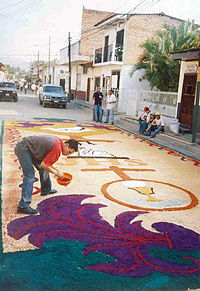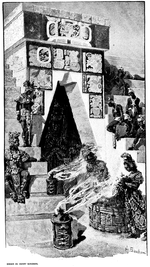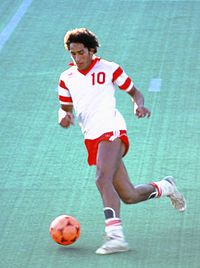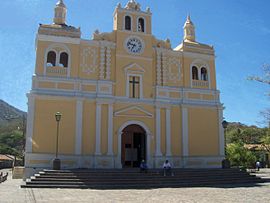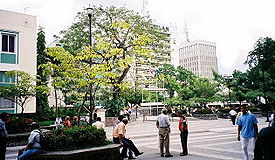- Culture of Honduras
-
The wealth of cultural expression in Honduras owes its origins primarily to being a part of Latin America but also to the multi-ethnic nature of the country. The population comprises 90% Mestizo, 7% Amerindian, 2% Black and 1% Caucasian. This influences all facets of the culture: customs, practices, ways of dressing, religion, rituals, codes of behavior and belief systems.
Contents
Popular culture
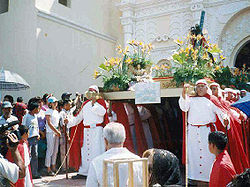 Procession in Comayagua
Procession in Comayagua
Popular culture in Honduras, as in most countries, is expressed not so much through sophisticated artistic creations, but rather by popular events that draw big crowds. In Honduras, such artistic and cultural events are held on specific days of the year and through special celebrations. They have a special kind of dance and music the Hondurans hold proudly. They have gatherings to sing and dance; they call it "punta".
Hondurans celebrate national holidays and special events in the form of carnivals, fairs and parades throughout the year. For instance, in La Ceiba the annual carnival is a week-long celebration with music, exhibitions and special food, culminating in the most popular carnival in the country: "The Carnival of Friendship".
The Feria Juniana (June Fair) of San Pedro Sula includes different musical concerts performed throughout the week. Visitors can also attend sporting events and a variety of exhibitions.
Puerto Cortés celebrates its fair in August with a "Venice" theme which includes parades of gondolas and other boats in the bay, and an evening fireworks display launched from boats.
Being a predominantly Catholic country, Honduras gives special attention to the celebrations of Holy Week. In some regions of the country, such as Comayagua, Choluteca, Copán and Intibucá, processions are held, especially during Thursday and Good Friday. Through these events, Hondurans commemorate the sacrifice they believe Jesus Christ made for humanity by reenacting the events that happened during the week between Palm Sunday and Jesus Christ crucifixion. The most outstanding event is the creation of the sawdust carpets. People will decorate the trail where Jesus will walk through (to his crucifixion) to make the walk less painful for Christ. Some people - particularly the inhabitants of the North and South Coast - use this week as an opportunity to visit beaches, rivers and swimming pools, due to the stifling heat that reigns during this time of year.
Hondurans celebrate Christmas Eve and New Year's Eve on the 24th and 31 December respectively. During these celebrations, the majority of Honduran homes cook special dishes to mark the occasion. Favorites include tamales wrapped with banana leaves, roast pigs' legs, and pastries. All of these celebrations are complemented at the end of the night with fireworks and firecrackers.
Other celebrations of special interest to Hondurans include Mothers' Day, Children's Day, Labor Day, Teachers' Day and Friendship Day.
Ethnic cultures
Lenca Culture
About 6% of the Honduran population are indigenous people sub-divided into small groups as follows: Lenca, Xicaques, Miskitos, Payas, the Ch'orti', and others. During the Spanish invasion of the 16th century, the Lenca organized a decade-long war of resistance. Chief Lempira, one of the most important Honduran heroes, was from the Lenca tribe. His death at the hands of Rodrigo Ruiz allowed the conquest of the final part of Honduran territory by the Spanish.
The Lencas have lost their language and the majority of their religious practices. However, they still make peace agreements in the traditional way, offer gifts to their ancestral gods, and some of their original forms of dress are still preserved. Basic nutrition comes from grains, especially corn, from which they produce a drink called "Chicha". Pottery is also an important cultural element for the Lencas artistically and economically.
Famous Hondurans
Honduran Cardinal Óscar Andrés Rodríguez Maradiaga was a candidate to replace Pope John Paul II after his death in 2005.
Salvador Moncada is a scientist of Honduran origin. He is married to Princess Marie-Esméralda of Belgium. His principal area of study is pharmacology, especially with respect to the effects of products of the metabolism of diverse acids, as well as the synthesis, action, and degradation of the biological mediator nitric oxide.
America Ferrera, an American actress, was born in Los Angeles to Honduran parents. Best known for the lead role in ABC's "Ugly Betty", she has also been successful on the big screen with her role in Real Women Have Curves. She has also won a Golden Globe Award and received recognition from the Screen Actors Guild.
David Archuleta, finalist and runner-up of season 7 of "American Idol," and Jive Records artist, was born in Miami, Florida to a Honduran mother, Lupe, and an American father, Jeff. On September 17, 2009 he was awarded Male Music Rising Star at the 2009 ALMA Awards (American Latino Media Arts Awards). David performed "Contigo En La Distancia" on the show, receiving strong praise and recognition from critics and viewers alike. He has also won five Teen Choice Awards.
Neyda Sandoval and Satcha Pretto work with Univisión of the United States. Renán Almendárez Coello from Honduras is the morning man on radio station KLAX-FM of Los Angeles. He has been active in charity work, assisting the poor of Central America and Mexico.
In sports, Hondurans stand out in soccer. Among the most outstanding players are José Cardona who played for Atlético Madrid in Spain; Gilberto Yearwood who played in Elche, Spain; Porfirio Betancourt, who played in France; Carlos Pavón, who currently plays for Real España; and David Suazo, current player of Internazionale, who was named The Most Valuable Foreign Player of the Italian league in 2006. Others include Julio César de León in Torino, Italy; Edgar Álvarez in Bari, in Italy; Wilson Palacios in Tottenham Hotspur of England, Maynor Figueroa in Wigan of England; Amado Guevara in Motagua, Honduras; and Carlo Costly in SC Valsui of Rumania.
Music
Main article: Music of HondurasSome notable Honduran musicians include Rafael Coello Ramos, Lidia Handal, Victoriano López, Guillermo Anderson, Victor Donaire, Francisco Carranza, Camilo Rivera Guevara, and Moisés Canelo.
At the international level the musical group Banda Blanca stands out, with their hits "Sopa De Caracol", "Do you Know Who Came?" and "Fiesta". Although the group produces merengueros rhythms, the Calypso and other Caribbean rhythms, their specialty is the Punta style, which they popularized during the 1990s.
Other musical groups include The Professionals, The Gran Banda, The Rolands, the rocker group Black Devils, and Trilogy.
Cuisine
Main article: Honduran cuisineThe baleada is a representative dish of the Honduran gastronomy. It consists of a flour tortilla which is folded and filled with refried beans, quesillo cheese or Parmesan cheese and sour cream. Roast meat or scrambled eggs can be added if desired.
Other popular dishes include grilled meat with chimol (diced tomato, onion and bell pepper); carne asada (roasted meat); chicken with rice and corn; fried fish with pickled onions; and fried or baked plantain. In the coastal areas and in the Bay Islands, seafood and meats are sometimes prepared with coconut milk.
Among the soups the Hondurans enjoy are bean soup, Sopa de mondongo (tripe soup), seafood soup, and beef soup, all of which are mixed with plaintains, cassava, cabbage, and other vegetables, and complemented by corn tortillas.
Other typical dishes are montucas (corn tamales filled with meat and vegetables), stuffed tortillas, and tamales wrapped up with banana leaves. Honduran cuisine also features an abundant selection of tropical fruits such as papaya, pineapple, plums, sapotes, passion fruits, and bananas, which are prepared in many ways while they are still green.
Religion
Main article: Religion in HondurasCathedral in Amapala
Honduras enjoys freedom of worship. Hondurans are predominantly Christian with an increasing number practising evangelicalism.
The second[1] Catholic mass celebrated in continental American territory was carried out on August 14, 1502 in Punta Caxinas, two weeks after the discovery of Honduras by Christopher Columbus. The Catholic faith is still strong among Hondurans. The Catholic Church in Honduras is composed of eight dioceses: Tegucigalpa, Comayagua, Choluteca, Olancho, Yoro, San Pedro Sula, Trujillo and Copán, which are a part of the Conference Espiscopal of Honduras.
Protestant churches are structured into three confederacies: The Shepherds' Association of Honduras, the Evangelical Brotherhood of Honduras and the Apostolic Network of Honduras.
In recent years, both the Roman Catholic Church and the Protestant churches, especially the Pentecostal denominations, have experienced growth in the number of new parishioners. The churches make use of TV stations, radio, newspapers, universities and the Internet.
In addition to these Christian religions, there are significant groups who profess Islam and Judaism.
The Press, Television and Radio
The first printing press was brought to Honduras by General Francisco Morazán from Guatemala. He used it to begin publication in 1830 of The Gazette of the government. Bulletins and informative weekly papers soon followed.
In 1831, the newspaper known as The Beam was born, which had a short duration. At the end of 19th century, The Chronicle commenced publication; next came The Newspaper of Honduras and The People (an official newspaper of the Honduran Liberal Party, which later ceased publication).
Honduras has a good number of newspapers and magazines, through which the Honduran people stay well informed. Of these the oldest is La Prensa, founded on October 26, 1964 in San Pedro Sula. El Tiempo has been in publication since 1970. In the capital city of Tegucigalpa, The Tribune and later The Herald appeared in the mid 1970s.
With the Internet came hondudiarioh.com, Proceso Digital and the English weekly paper Honduras This Week. Recently sports magazines such as AS and Diez have appeared, with an emphasis on soccer.
Television arrived in Honduras in 1959 with the arrival of channel 5. Today there are five channels produced in Honduras.
Except for the news and sports programs, for many years these channels transmitted programs produced in Mexico and Venezuela. As a result of this, many Honduran were influenced by the cultures of these countries, adopting their sayings and behavior. With the arrival of the cable system, Hondurans have the opportunity to watch programs from Spain, Argentina, and the United States. The cultural impact of these programs remains to be seen.
Radio also has contributed to the cultural development of Honduras. Major players include Radio America and HRN, a member of the National System of Broadcasting Stations.
Bibliography
- 'Sociology', por Alex Thio. 5th edition. Addison-Wesley Educational Publishers Inc.
2 www.wikianswers.com
References
- ^ São Salvador de Bahia de Todos os Santos
- ^ Humphrey, Chris “Holy Week in Comayagua” February 2,2011 < http://www.moon.com/destinations/honduras/central-honduras/comayagua/holy-week-comayagua
- ^ http://www.mapzones.com/world/central_america/honduras/introindex.php
See also
- Honduran literature
- Latin American culture
- Hispanic culture
Latin American culture North America 
Central America - Belize · Costa Rica
- El Salvador
- Guatemala
- Honduras
- Nicaragua
- Panama
Caribbean - Antigua and Barbuda
- Bahamas
- Barbados
- Cuba
- Dominica
- Dominican Republic
- Grenada
- Haiti
- Jamaica
- Puerto Rico1
- St. Kitts and Nevis
- St. Lucia
- St. Vincent and the Grenadines
- Trinidad and Tobago
South America - Dependencies not included.
- 1 Defined as a semi-autonomous territory.
Categories:- Honduran culture
Wikimedia Foundation. 2010.


